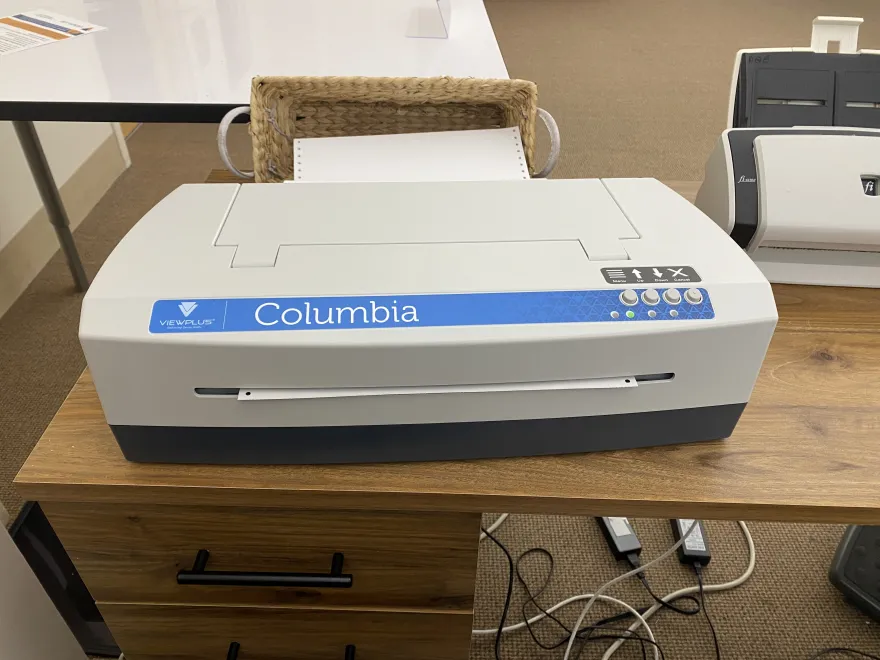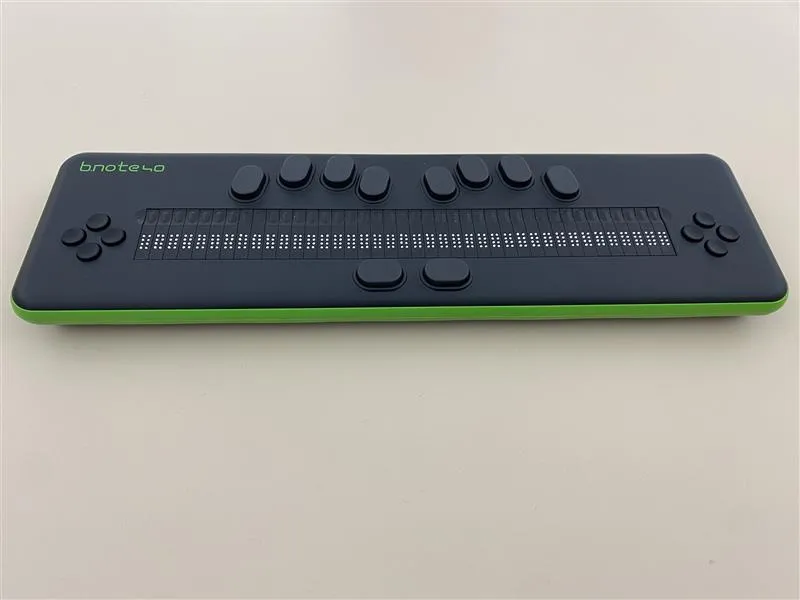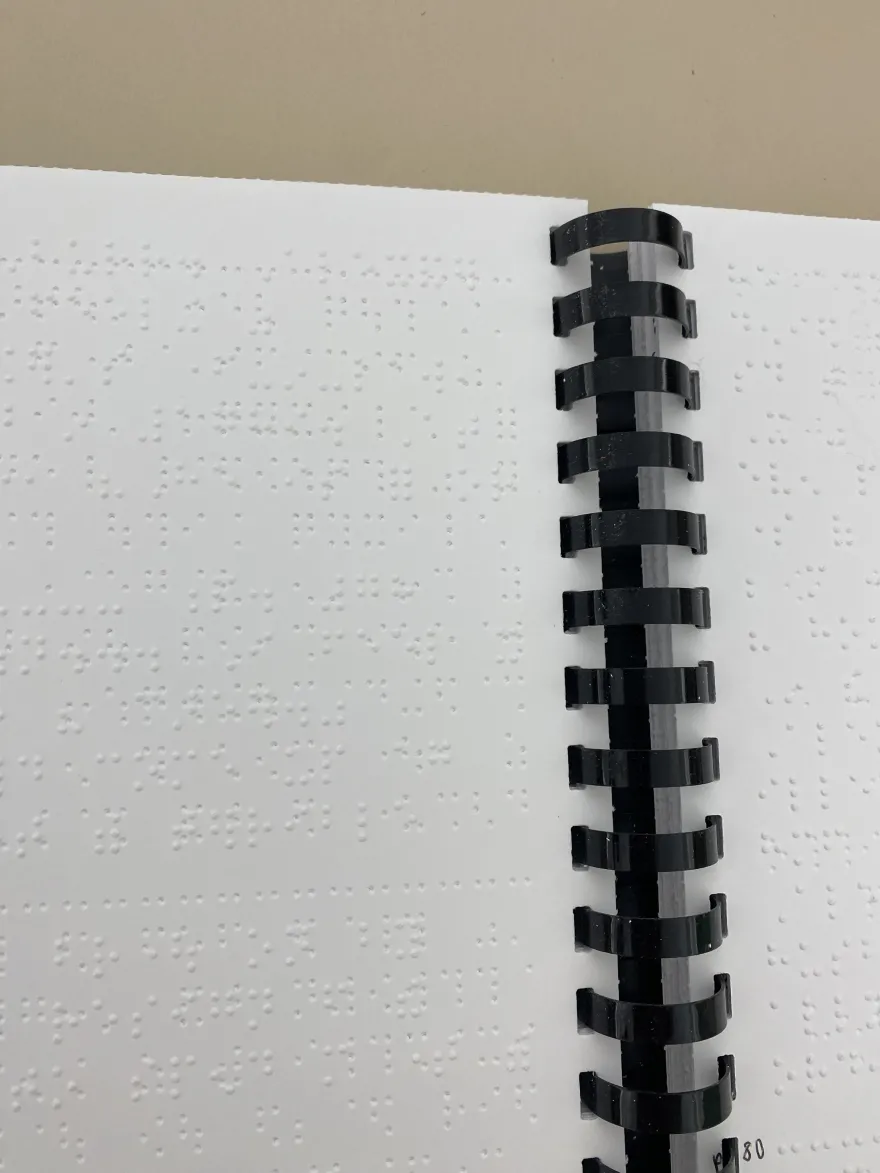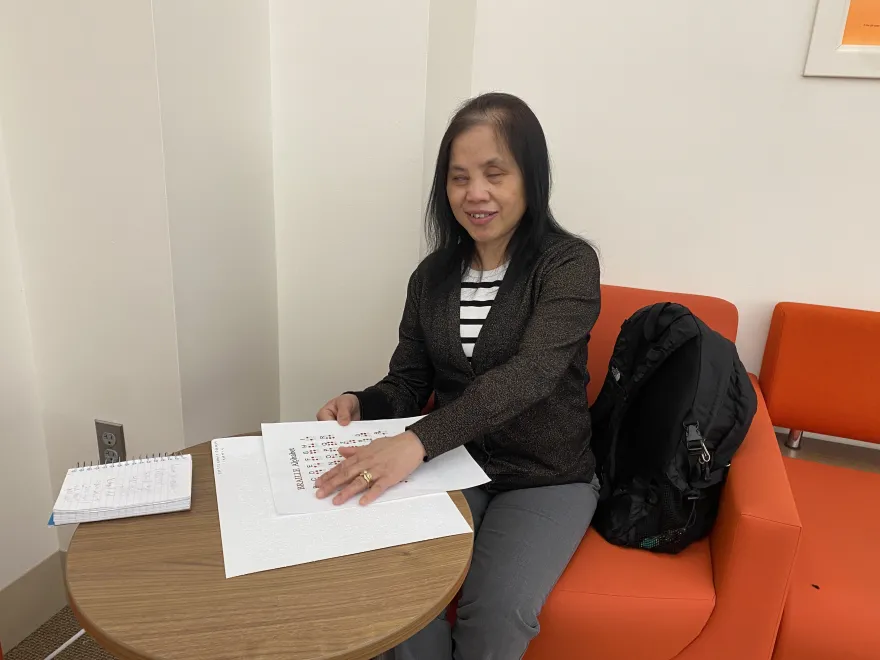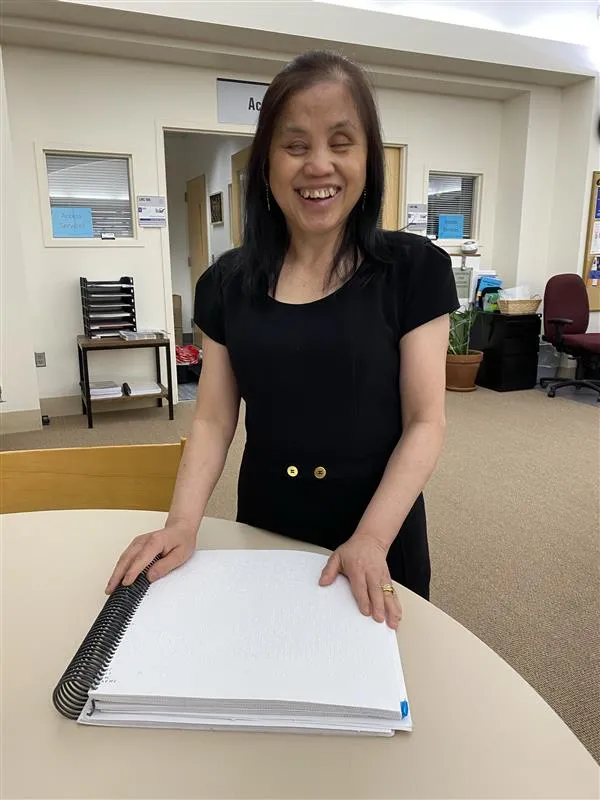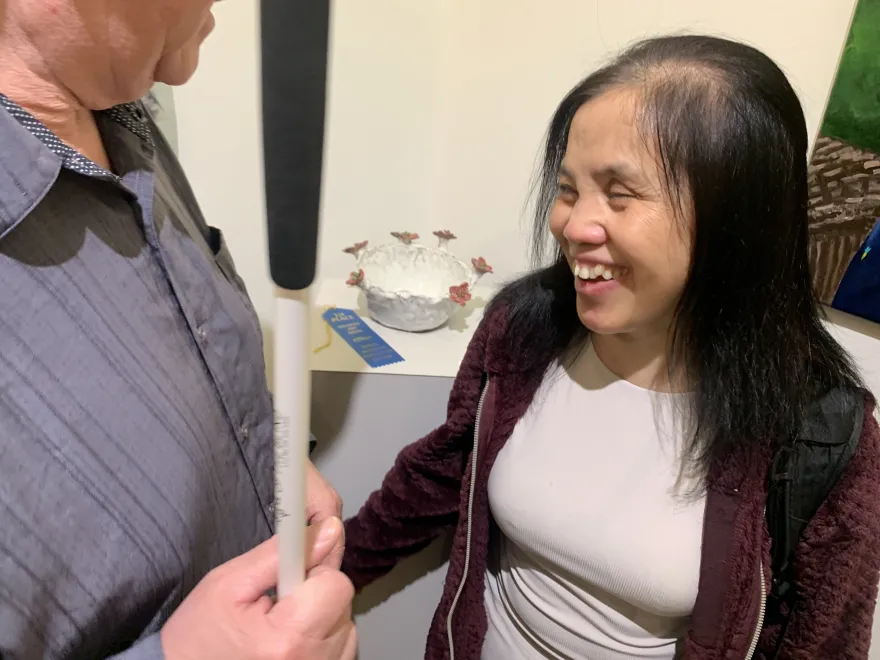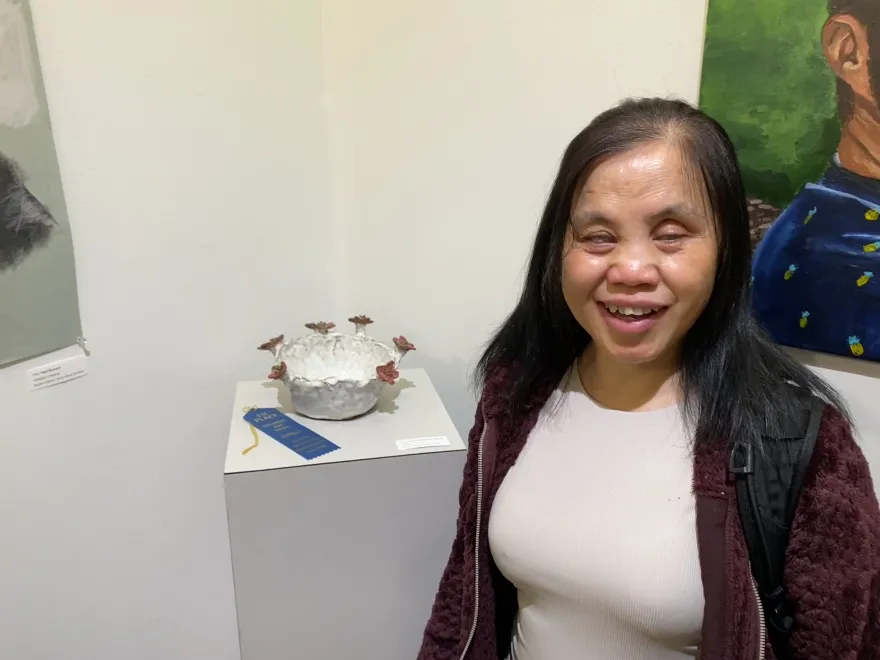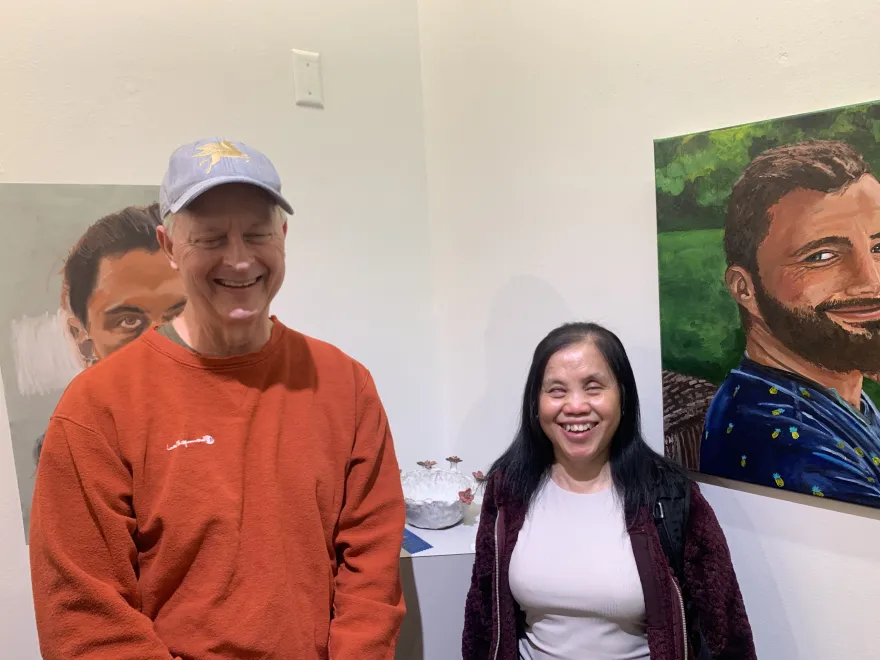
Meet May, a non-traditional, vision impaired student at NHCC, who is majoring in social work. May first learned braille when she was 14 years old, living in Laos. In 2008, she came to Minnesota and started at NHCC last semester. This spring, NHCC received a generous donation that brought state-of-the-art braille technology, namely, a Braille printing/embossing machine, and a smart-touch Braille display device to campus – opening new doors for blind or low vision students, like May.
Since the new equipment became available at NHCC, May has noticed a night and day difference and overall improvement in her academic experience.
"This Braille embosser is really important to me. Having the Braille embosser helps me finish my homework and learn how to spell. It helps my reading and pronunciation and that makes me more comfortable. First semester, I was frustrated, but now I feel happier and more confident. Having the Braille embosser and the support staff helps me a lot! I'm so thankful to have staff like Jessica and Elianna here, who help me, and they print the braille books and documents for me. I am also thankful for the people who made the Braille machine donation possible for us."
Get to know May a little more in her Q&A, below!
What are you studying here at North Hennepin?
My major is social work.
Do you use a display device at home?
I do not have a refreshable Braille display at home. I only have a Perkins Braille embosser (like a typewriter), or my Slate and Stylus that I use to produce braille by hand.
Normally I bring my suitcase and large books with me, but today because I only have one class and it's ceramics, I don't need my suitcase and that's okay, because it's not easy for me to bring it everywhere. My braille textbooks are much thicker than the textbooks that sighted people use. One of my books, might be as thick as five print books. It's not easy on my back!
But let's say I had a book that was 100 pages, that might turn out to be super thick, like a 12-inch-thick print book! A lot of my braille books require multiple large volumes. I have a book for my reading class, and it has six volumes! Each volume is thicker, I'd say maybe two inches thick. Complete books with all the volumes take a lot of space. I cannot put all of them in a backpack, so I come to school every day with my suitcase.
My teacher has a device that can store books and be read using its refreshable Braille display, and she brings it with her everywhere she goes. But I don't have one. They are kind of expensive. The price for a device like this costs $1,000 to $6,000. A portable refreshable Braille display that can be used with a computer starts at about $800 and can be as much as $2,000. They are not affordable for me.
How many textbooks do you use?
I normally need the same number of books in braille that another student would be required to have in print. If it is a thick print book, then it might have to be broken up into a few physical books. Right now, I have only a few textbooks related to my degree, because I'm taking EAP classes right now. I will begin taking classes this summer that are required for my degree in social work.
NHCC’s Director of Access Services, Jessica Fraser joined the conversation, “She has one braille textbook for sure, for one of her EAP courses, but then she has a Harriet Tubman book that we just printed, which was cool, that was our first braille book that we had printed for her. To purchase a braille textbook, it costs around 15 to 20,000 dollars. Especially depending on the number of graphics that are in it. The Harriet Tubman book was probably around an inch thick after we printed it. One page of printer paper is roughly two and a half pages of braille paper once it has been printed. “
Do you like listening to books more, or reading them?
Well, I enjoy listening to audiobooks as much as anyone else, but when it comes to textbooks, I need these in braille. Reading in braille for me, works the same as reading in print for you. I am able to focus on the words in the text and learn how words are spelled. As you know, textbooks usually have many words that may be unique to the subject I am studying, and I wouldn’t know how to spell them if I was just hearing it in a recording. I do find it helpful to listen to a textbook as I am reading it in braille, as it allows me to learn how these new words are pronounced. I am still in the process of learning English, so knowing how to spell and pronounce new words is vital. When I am able to read information in braille at the same time that I am listening to something, it helps me to understand, helps me to do my homework and helps me practice my spelling. For me, I don't want anything special, I just want access to the same information that sighted students have; we both have to read the textbook. I can also access some information using a screen reader on my iPhone, or my computer. Using a screen reader, I can read Word documents and read many websites.
When did you learn how to read braille?
I learned braille when I was 14 years old. I was a child, living in Laos. There was no school for blind people, or blind students in Laos until 1995. At that point I was 14 already. So that's when I learned to read braille.
Jessica added, “A lot of our other students who are visually impaired, they actually don't know braille. So, I think depending on the school, you don't learn it. If you if you went through mainstream school. You used other things like magnifiers and audios. I think those who grew up with it, if you grew up blind, then you are more likely to use it. But if you have lost your sight throughout the years, then you don't really use it.”
Has it taken you a while to practice the braille and get it down?
Yes. I know how to read braille because I practiced it at an early age. I first learned Laotian braille and now I know Laotian braille and English braille. The first time, I felt these dots when I went to my blind school in Laos, it gave me a headache, you know what I mean? I was like, 'What does this mean?' 'What does that mean?' But after that, it took me only one week and I had it all down. But it was a slow process to logistically implement it into my life and my academics. I'm faster at reading in braille than other people I know and it's easy for me. But that doesn't mean that I do everything fast. Like I said, it might take you only two minutes to read through something, but it takes me 10 or 15 minutes to look at a page in its entirety. Because I read the page, okay then I read the worksheet questions, and it asks me, 'What kind of animals do you see?' Then I have to read the image description and there's just a lot more to read.
(May has a worksheet on the table for chapter four of her Harriet Tubman book. This is a worksheet for her EAP class.)
How do you complete your worksheets?
I don't do it on the worksheet. Once I get home, I submit my assignment. I go back to read and type on my computer and email my teacher, so she can check my work.
What does it mean to you to know that we have this machine here that can do the braille printing?
It’s awesome! It helps me a lot. It's really important to be able to read documents and textbooks in braille. It helps me learn how to spell, how to read, and how to understand. If I listen to the document using a screen reader on my computer, it just reads back to me so fast. But when I read a worksheet in braille, 'What is the animal in the picture?' I can do both at the same time. I can listen, I can read, I can practice my spelling at the same time. Braille is so important. And now, I'm more likely to complete the reading successfully. This Braille embosser helps me finish my homework and learn how to spell. It helps my reading and my pronunciation and that makes me more comfortable. Now I'm happy and confident! First semester, I was frustrated, but now I feel more confident. Having the Braille embosser and the support staff helps me a lot!
Jessica added, “A few months ago, one of May's homework assignments was to learn a map of the world. We didn't have a braille map at the time, so we used puffy paint on a map. By using the raised glue, puffy paint, May could navigate between, what is North America, what is South America. Then we were able to label the equator in braille when we finally got the embosser machine.”
Did you previously work in the massage therapy field?
Yes, that I was the program that I graduated from in Laos. I worked as a massage therapist. As I got older, it became harder on me to give the massages. When you're younger, it’s no problem and you have all the physical energy. But when you get to being my age now, I just cannot do it anymore. I do have some people that I still give massages to, but afterward my muscles ache.
What kind of social work do you want to do?
I would like to help people like me, and I’m interested in family issues. I would like to work in foster care, or with children who don’t have parents. I think I would really enjoy that, because I love children. I like to help people. I went through a situation like that, and I know, you need support from someone. I believe someone is out there who needs the support that I can offer them. I think I could be that support for someone. That's what lead me to choose social work as my major.
Jessica added, “Now, May can take her Accuplacer placement test in braille, (getting her closer to starting courses for her social work major). We didn't have these resources before, and we're going to allow her to retest because we think she can test higher now than where she was at prior. Our hope is that she can use the new display device that we have now, for the test, too.”
Have you found it helpful to work with Jessica at NHCC?
Yes, Jessica’s support has been extremely beneficial, and I rely on her to help me to get the information that I need in braille, and she's always there for me.
How does your screen reader work at home?
On my Mac laptop, it comes with a program called Voiceover. On my Windows laptop it is a separately purchased software program called JAWS (Job Access With Speech). My Mac laptop is very old, and slow, and thankfully, State Services for the Blind provided me with laptop computer set up with the JAWS program. I use JAWS to read, because I need the sound. Like when I saw your email it said, 'Sara Barrera would like to meet…’ so yes, my screen reader will read the emails for me. I can control the voice of the screen reader and change how fast of speech I need. I normally do 50% for my speech speed so I can read it properly.
Do you like doing homework?
Do I like it? No. But I haven’t graduated yet with my degree, so I have to do it, you know? For example, people ask me, ‘Do you like to cook?’ I say, ‘No, I don't, but I want to eat. So, I need to cook!’
Along with reading, is it helpful for you to talk through what you're learning also? For example, after you read a chapter, do you like to talk someone about it?
Oh, yes, I like to have discussions with my husband. Sometimes I’ll talk to him and tell him what I’ve learned. It’s a good thing my husband likes to talk a lot like me! Haha!
In your family, do you have any kids, or is it just you and your husband?
I have one daughter. She is 22. She stays with me, and she is a senior in college now at Bethel University.
You’re taking a ceramics class at NHCC this spring. How did you decide to take that class?
It is a fairly easy class; I can do that and go home after and there's no homework. I also think because it's my first year in college, it's just good to get class experience. Before taking this class, I went to classes at BLIND Inc, I called that my 'pre-school' and that's where I got experience taking classes and I learned about the art industry. I took an Industrial Arts class, where I learned things like how to make a table and how to use a saw to cut your wood. I made my own bookshelf, and I store all my braille books on it now. The shelf I made is taller than me, it's five feet tall and I'm four feet ten inches! I'd like to experience every class if I could. It's good to learn things, good to explore and have new experiences. The people in my classes and my teachers are nice.
Following May's recognition at the 2025 Student Art Show Reception, NHCC ceramics instructor, Glenn Grafelman wanted to pass along a few kind words, "May Spooner has been an exceptional Ceramics Student, we have enjoyed working together in class. I am very proud of her interest and accomplishment in Ceramics. I have 46 Ceramics Students this semester. May is surprisingly fearless in her artistic pursuit.”
What classes are you going to take over the summer?
I think I know what classes I want to take this fall, but I prefer to have my advisor help me with that. I will be meeting my advisor, Brian, soon. He will look at all of my classes with me and make sure everything I’ve taken so far goes through, so I can move on to my major courses quickly. Because at my age, I’m old. I don't want to graduate when I’m 60 years old. Once I graduate, then I’ll need to try to find work, you know? If you graduate when you're of a younger age, it’s better and there’s more benefits.
Jessica added, “You love learning, May. You’re a lifelong learner!”
What would you like students to know, if other students are vision impaired, do you have any advice for going to college?
My advice to other students who are vision impaired is never give up, no matter how you look, or what you have, or what don’t have. You know, for me, for example, I have no eyesight. If there’s something you want to do, you need to do it. I believe that you can get to your dream. If you have a dream, like me, just keep going and never give up. It’s not easy but you have to continue.
What school did you previously attend?
I came to Minnesota in 2008 and the school I went to was called, BLIND Inc. (Blindness Learning In New Dimensions) I took classes there from 2009 to 2010. Blindness is normal there, that’s the training that you get, and the teachers, they help you there. In general, that was a hard time for me, because that’s right when I moved to this country, and I only knew a little English. Plus, in that time, I also had to learn things like how to properly cross the street, when I know there’s a green light and a red light, but I can’t see them. That was one of the most difficult things I ever had to learn. At BLIND Inc. I took a class there that were super hard for me. I had a teacher who put me in a car and then dropped me off someplace like a couple miles away from my school. That was their training. They needed to train me so I could learn how to get from place to place. It was scary. They dropped me off, said, “Bye, May, find your way back to school” and they drove away. I had to figure out my way back to the school. Finally, I made my way back to the school at Lake Street and 22nd in South Minneapolis. I got lost, but people helped give me directions of which ways to go to get back to school. From that experience onward, I was able to use my cane and walk and find my way back to my school. The first time I had to walk and get back to school, it was super difficult for me, and I cried. I never cry, but I cried while taking that class. I talked to my teacher and said, ‘I don't want to do this, it stresses me out.’ He responded back to me and said, ‘If you don’t do this, you’ll never graduate from this school, or this program.’ I cried, but then I was like ‘Okay, forget it. I’ll go practice it again.’ But then I did it! I got it down, but it was not easy. Now, BLIND Inc. has closed. But it was a really good school for blind people to get training. That was the school that dropped me off in the car and had me find my way back to school, because I took something called a travel class.
Do you like to travel?
Yes, I do, but I haven’t had the opportunity to do much traveling in U.S. I enjoy traveling to North Dakota to visit my husband’s family. When my husband was still working, I traveled with him to places like Milwaukee, WI, Orlando, FL, Boston, MA, Baltimore, MY and Harrisburg, PA.
How did you find out about North Hennepin?
How did I find this school? Well, I live close to here and it’s easy to get to. I asked Google ‘What colleges are near me?’ I knew I wanted to be a social worker, so honestly, in my brain it was just my understanding that every college might have that program. That was what I thought. I just assumed that college means you have everything, and all of the programs that people want would be here.
Why do you like going to school here?
I like going to this school because it is closer to my house and easy to get here. I think there are many good qualities about going to school here, and there are good programs to apply to here. There are good programs here that allow me to learn and practice, before I get to my degree.
In general, why is it important to go to college?
That's a good question. Because I like to learn, and expand my mind and ultimately, I want to get an education so I can help other people. That's what I want to do. I like to help people, and I like to talk a lot. I think it is good to get a degree with the goal of helping others in need. I might need to help someone who is going through the same thing that I went through. I could help someone in the same ways that other people have helped me in the past. I'm so thankful to have staff like Jessica and Elianna here, who help me, and they print the braille books and documents for me. I am also thankful for the people who made the Braille machine donation possible for us.
Thank you for answering our questions, May, it was wonderful getting to know you! We wish you the best of luck as you continue with your classes and move into your future career as a social worker!
